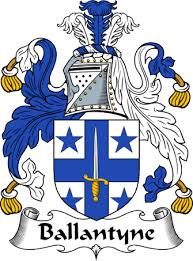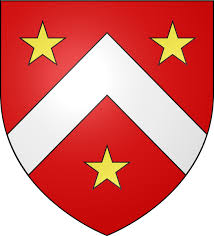JMF genealogy

Ballantyne
Ballantyne
Origin of the Ballantyne surname
Historians generally agree that the name Ballantyne was formed by combining two ancient Gaelic words: Belenus (the name of the sun god in Celtic mythology) and teine (fire). The combination means fire of Belenus which is a reference to the tradition of lighting bonfires in the sun god's honour at the start of Spring (when the sun starts to get stronger). This celebration was traditionally known as the Beltane festival and was held on 1 May. These traditions are the origins of the modern concepts of bonfire night and Mayday.
Perhaps a Ballantyne ancestor was born on the day of the Beltane festival; became known as Belinus-teine; and the name was retained by his descendants. Alternatively, the family may have derived its name from its ownership of the land on which the festival took place each year.
Some Scottish historians have suggested an alternative origin for the name. Their theory is that the name could derive from an old Gaelic phrase baile an deadhain which means the farmstead of the dean. However, these historians can't agree whether the name originates in Roxburghshire, Stirlingshire or Selkirkshire.
It is likely that the name had a single origin because it is quite rare; rarer even than surnames known to have had a single progenitor in the eleventh century (such as Bruce and Douglas). In the 1841 census, Ballantyne (including its spelling variations) accounted for just 56 in every 100,000 people in Scotland while Bruce accounted for 231 and Douglas 232. The most frequent surname was Smith (1393 in every 100,000). Since the single progenitors of the Bruce and Douglas families lived during the eleventh century, it seems reasonable to conclude that the single progenitor of the Ballantyne family lived at a later time; probably the twelfth or thirteenth century. We know that the surname was well established by the fifteenth century.
Earliest known Ballantyne people
Some of the earliest Ballantynes in recorded history include:
- John Ballenden was archdeacon of Moray c1450
- Sir Richard Bannochtine of the Corhouse (fl. 1460) and his son Sir John Bannatyne
- Patrick Bellenden received a charter from the Earl of Morton in 1499 for lands in Auchinoul, Midlothian
- George Bannatyne (1545 - 1608) was a reknowned collector of Scottish poems
- Sir Alexander Balendin was provost of Methuen in 1563
In recent decades our family has adopted a standard spelling: Ballantyne. Previously the spelling varied wildly including Ballentine, Ballantine, Ballentyne, Ballintine, Bannentyne, Bannantyne, Bannatine, Ballanden, Ballenden, Ballendine, Ballendyne and many more. Other branches of the family have standardized on one of the alternative spellings.
Ballantyne Heraldry

Heraldry

There are two sets of heraldic arms associated with the Ballantyne family. Firstly (see left): gules a chevron argent between three mullets or. The other arms (see right) are argent on a cross between four mullets azure. Sometimes, as shown here, this latter crest has the addition of a sword proper pommeled and hilted or.
The Ballantyne motto is nec cito nec tarde - neither fast nor slow.
Two Ballantyne families
We have two families with the Ballantyne surname in our history. Margaret Scott Ballantyne's father was Thomas Ballantyne and her mother was Christina Ballantyne (nee Ballantyne). Both her paternal and maternal families came from East Kilbride in Lanarkshire.
Ballantyne migration to Australia
Margaret Scott Ballantyne migrated to Australia aboard the Eastern Monarch in 1883 with her husband Charles Fleming and son Charles Taylor Fleming. Her husband kept a diary for the journey that you can read here: Townsville or hell!
Ballantyne pedigree
Our Ballantyne ancestors include the following people. Click on any name to access a computer-generated page of information about that person and a list of the information sources.
- Margaret Scott Ballantyne (b. 6 Jan 1855, d. 23 Nov 1930)
- Thomas Ballantyne (b. 26 Jul 1826, d. 27 Mar 1873)
- Thomas Ballantyne (b. 2 May 1799, d. 14 Sep 1887)
- Thomas Ballantyne (b. ca. 1770, d. bef 1851)
- Jean Park (b. 9 Jul 1772, d. 21 Nov 1867)
- Peter Park (b. 1 Dec 1743)
- Peter Park (b. ca. 1700)
- Agnes McClean (b. ca. 1700)
- Janet Hamilton (b. ca. 1750)
- Peter Park (b. 1 Dec 1743)
- Margaret Scott (b. 1 Apr 1803, d. 27 Jan 1887)
- William Scott (b. ca. 1769, d. 15 Apr 1847)
- Margaret Craig (b. ca. 1776, d. bef 7 Apr 1861)
- Thomas Ballantyne (b. 2 May 1799, d. 14 Sep 1887)
- Christina Ballantyne (b. Aug 1826, d. 8 Mar 1867)
- William Ballantyne (b. 8 Jun 1789, d. 6 Mar 1842)
- Andrew Ballantyne (b. ca. 1760, d. aft 1795)
- Isabella Young (b. ca. 1760, d. aft 1795)
- Christina Dow (b. ca. 1801, d. 21 Apr 1877)
- James Dow (b. ca. 1768, d. 15 Apr 1856)
- William Dow (b. ca. 1740)
- Catherine Johnston (b. ca. 1742)
- Helen Frame (b. 18 Nov 1767, d. 23 Sep 1852)
- John Frame (b. ca. 1740)
- James Dow (b. ca. 1768, d. 15 Apr 1856)
- William Ballantyne (b. 8 Jun 1789, d. 6 Mar 1842)
- Thomas Ballantyne (b. 26 Jul 1826, d. 27 Mar 1873)
Notable Ballantyne ancestors
Click on the name of any of the notable ancestors listed below to read a short biography that I have written about them.
- Biography: Margaret Scott Ballantyne (1855-1930)
- Biography: Thomas Ballantyne (1770-) - Paternal side
- Biography: Thomas Ballantyne (1826-1873) - Paternal side
- Biography: Thomas Ballantyne (1799-1887) - Paternal side
- Biography: Andrew Ballantyne (1760-) - Maternal side
- Biography: William Ballantyne (1789-1842) - Maternal side
- Biography: Christina Ballantyne (1828-1867) - Maternal side
Ballantyne family memorials
For centuries families have created memorials to honour their forebears, including headstones, church monuments, memorial cards, obituaries and much more. This website is, in a way, just another innovation in this regard. Each of the links below takes you to a memorial page that is dedicated to that particular deceased ancestor.
- Margaret Scott Ballantyne 1855-1930 – and her husband Charles Fleming 1854-1928
Ballantyne Research Reports
The following Ballantyne research reports are published on this website.
- My tangled Ballantynes – How I straightened out the tangle caused when people with the same surname marry
- The Ballantyne Roadblock – I overcame this roadblock thanks to a DNA hint and good old-fashioned genealogical investigation
Ballantyne clan - Paternal side
The paternal Ballantyne clan descends from Thomas Ballantyne (1770-).
- Legend:
- Subject
- Daughter
- Son
- Spouse
- Legend:
- Subject
- Daughter
- Son
- Spouse
Ballantyne clan - Maternal side
The maternal Ballantyne clan descends from Andrew Ballantyne (1760-).
- Legend:
- Subject
- Daughter
- Son
- Spouse
- Legend:
- Subject
- Daughter
- Son
- Spouse